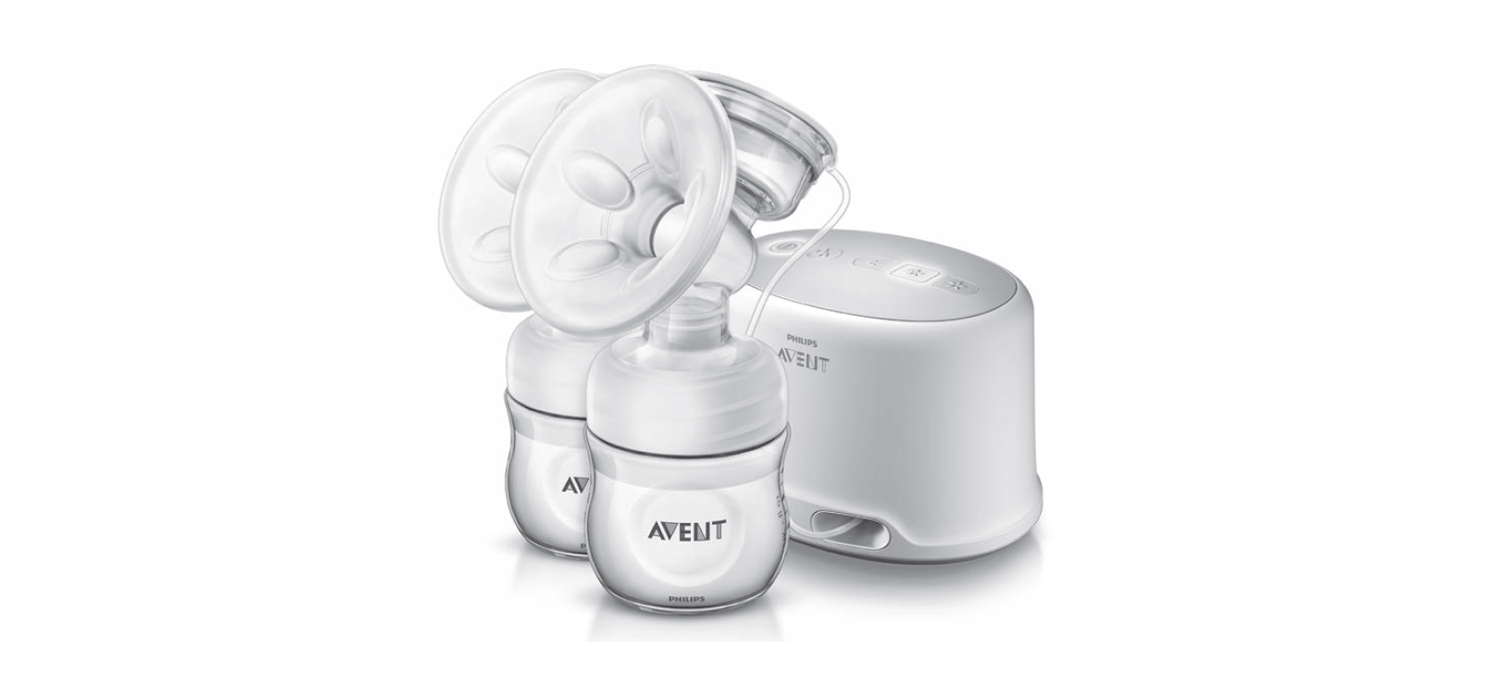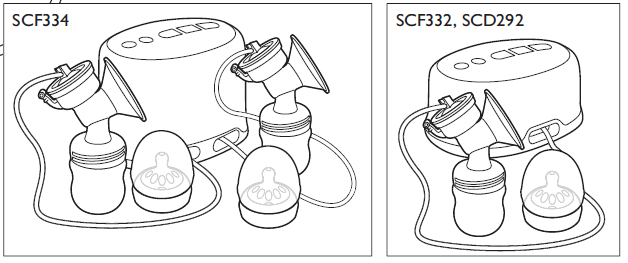PHILIPS AVENTComfort Double Electric Breast PumpUser Manual
SCF334, SCF332, SCD292
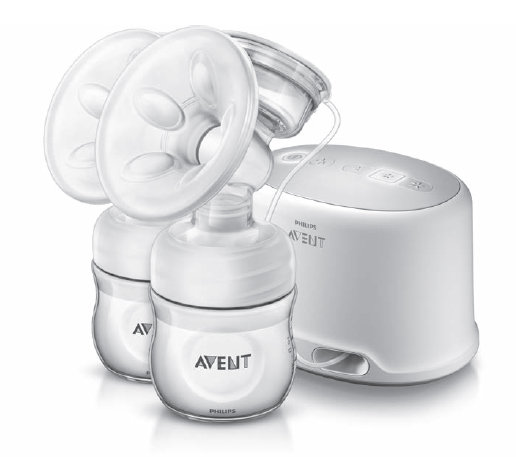
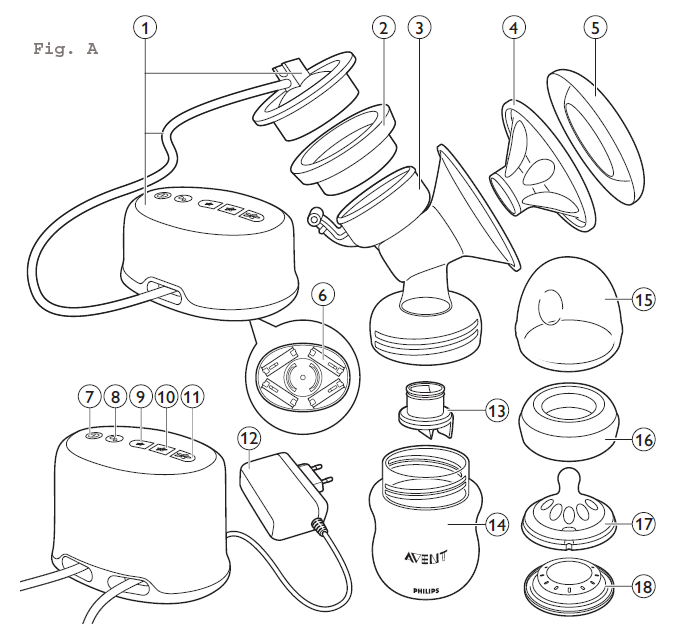
Introduction
Congratulations on your purchase and welcome to Philips Avent! To fully benefit from the support that Philips Avent offers, register your product at www.philips.com/welcome.
The Philips Avent breast pump has a unique design that enables you to sit in a more comfortable position while expressing. The soft massage cushion* is designed to feel soft and warm and to mimic your baby’s suckling action to provide milk flow – comfortably and gently. The power cushion is designed for stronger suction. The breast pump starts in a gentle mode that helps to stimulate your milk flow. You can then choose from three suction modes, according to your own personal comfort. The pump is easy to assemble and operate and all parts that come into contact with breast milk are dishwasher-safe.
Healthcare professionals say that breast milk is the best nutrition for babies during the first year, combined with solid food after the first 6 months. Your breast milk is specially adapted to your baby’s needs and help protect your baby against infection and allergies. A breast pump can help you to breastfeed longer. You can express and store your milk so that your baby can still enjoy the benefits, even if you cannot be there to provide it yourself. As the pump is compact, quiet and discrete to use, you can take it with you anywhere, allowing you to express milk at your own convenience and maintain your milk supply.
This breast pump is for household use only.*The cushions included with this pump were designed to comfortably fit the majority of mothers.However, if you need it, you can buy a larger cushion separately.
General description (Fig. A)
Figure A. The numbers mentioned below refer to the numbers on the figure on the front foldout page of this user manual.
- Motor unit with silicone tube and cap *
- Silicone diaphragm *
- Pump body *
- Massage cushion *
- Cover *
- Battery compartment(single electric breast pump only)
- On/off button
- Stimulation button
- Low suction button
- Medium suction button
- Deep suction button
- Adapter
- White valve *
- Philips Avent Natural bottle *
- Dome cap *
- Screw ring *
- Teat *
- Sealing disc *
*Note: The twin electric breast pump comes with two pieces of the marked parts, except for the motor unit.
SCF332 contains: single electric breast pump (including 1 bottle), breast padsSCF334 contains: twin electric breast pump (including 2 bottles), breast pads, travel bagSCD292 contains: single electric breast pump (including 1 bottle), 9oz bottle (1), power cushion, storage cups (10), storage cup adapter (2), nipple cream, nipple protectors, breast pads (18)
Intended use
The Philips Avent Comfort Single/Twin electric breast pump is intended to express and collect milk from the breast of a lactating woman.The device is intended for a single user.
Important safety information
Read this user manual carefully before you use the breast pump and save it for future reference.This user manual can also be found online via the Philips Avent website: www.philips.com/avent
Contraindications
Never use the breast pump while you are pregnant, as pumping can induce labor.
Warning
Warnings to avoid choking, strangulation and injury:
- Do not allow children or pets to play with the motor unit, the adapter or accessories.
- Children should be supervised to ensure that they do not play with the appliance.
- Always unplug the breast pump immediately after use.
- Do not leave the breast pump unattended when it is plugged in.
- This breast pump is not intended for use by persons (including children) with reduced physical, sensory or mental capabilities, or lack of experience and knowledge. Such persons can only use this breast pump if they are supervised by or have received proper instruction concerning use of the appliance by a person responsible for their safety.
Warnings to avoid electric shock:
- Inspect the breast pump, including the adapter, for signs of damage before each use. Do not use the breast pump if the adapter or plug is damaged, if it does not work properly or if it has been dropped or submerged in water.
Warnings to prevent burns:
- Only use the adapter indicated on the appliance to prevent overheating of the adapter.
- Non-rechargable batteries are not to be recharged to prevent overheating and leaking of batteries.
Warnings to avoid poisoning and contamination and to ensure hygiene:
- For hygienic reasons, the breast pump is only intended for repeated use by a single user.
- Clean, rinse and disinfect all pump parts, except the motor unit, the tube and cap and the adapter, before each use.
- Only store breast milk collected with a cleaned and disinfected pump.
- Do not use the breast pump if the silicone diaphragm appears to be damaged or broken. See chapter ‘Ordering accessories’ for information on how to obtain replacement parts.
- Do not use antibacterial or abrasive cleaning agents when you clean breast pump parts.
- If you are not going use the appliance for a long period of time, remove the batteries to prevent leaking of batteries.
Warnings to avoid breast and nipple problems and pain:
- Do not attempt to remove the pump body from your breast while under vacuum. Switch off the appliance and break the seal between your breast and the pump funnel with your finger. Remove the pump from your breast.
- Never use the breast pump while you are sleepy or drowsy to avoid lack of attention during use.
- Always switch off the breast pump before you remove the pump body from your breast to release the vacuum.
- Never use any accessories or parts from other manufacturers or that Philips Avent does not specifically recommend. This could lead to improper working of the appliance and could influence Electromagnetic Compatibility (EMC). If you use such accessories or parts, your warranty becomes invalid.
- Do not continue pumping for more than five minutes at a time if you do not succeed in expressing any milk. Try to express at another time during the day.
- If the process becomes very uncomfortable or painful, stop using the pump and consult your breastfeeding advisor.
- If the pressure generated is uncomfortable or causes pain, switch off the appliance, break the seal between the breast and the pump body with your finger and remove the pump from your breast.
- Never drop or insert any foreign object into any opening.
Caution
Caution to prevent damage to and malfunctioning of the product:
- Prevent the adapter and motor unit from coming into contact with water.
- Keep the adapter and the silicone tubes away from heated surfaces to avoid overheating and deformation of these parts.
- Never put the motor unit or the adapter in water, in a dishwasher or in a sterilizer.
- Although the breast pump is compliant with applicable EMC directives, it may still be susceptible to excessive emissions and/or may interfere with other equipment. A consequence can be that the breast pump switches off or goes into error mode. To prevent interference, keep other electric equipment away from the breast pump during expressing (see ‘Technical information’).
- There are no user serviceable parts inside the motor unit of the breast pump. No modification of equipment is allowed. If you do, your warranty becomes invalid.
- Do not short-cut the supply terminals of the batteries
Preparing for use
Cleaning and disinfection
The motor unit, the silicone tube, cap and the adapter do not require cleaning and disinfection, as they do not come into contact with breast milk. Clean and disinfect all other parts of the breast pump before first use. Also clean these parts after each subsequent use and disinfect them before each subsequent use.
Caution: Never put the motor unit or the adapter in water, in a dishwasher or in a sterilizer, as this causes permanent damage to these parts.
Cleanable parts
Clean the following parts before (first) use and after each subsequent use. Please check the list in the General Description section to see which items are included with your breast pump.
Breast pump parts:
- Silicone diaphragm
- Pump body
- Massage cushion
- White valve
- Cover
- Power cushion
Bottle parts:
- Philips Avent Natural bottle
- Dome cap
- Screw ring
- Teat
- Sealing disc
Accessories
- Philips Avent storage cup
- Philips Avent storage cup adapter
Supplies needed for cleaning:

Warning: Do not use antibacterial or abrasive cleaning agents when you are cleaning.
- Disassemble the breast pump and bottle completely. Also remove the white valve from the breastpump.Caution: Be careful when you remove the white valve and when you clean it. If it gets damaged, your breast pump does not function properly. To remove the white valve, gently pull at the ribbed tab on the side of the valve.
- Wash the parts in the sink or dishwasher.Washing in sink: Detach all parts and soak for 5 minutes in hot water with some mild dishwashing liquid. Clean all parts with a soft brush or clean dish towel and then rinse them thoroughly (Fig. 3). Washing in dishwasher: Clean the parts, except the motor unit, the silicone tube and cap and the adapter, in the dishwasher (on the top rack only).Note: To clean the valve, rub it gently between your fingers in warm water with some washing-upliquid. Do not insert objects into the valve, as this may cause damage.
Disinfection
After cleaning, disinfect the parts that come into contact with the breast and breast milk.
Supplies needed for disinfection:
- A household pot
- High-quality drinking water
Disinfect the parts in the following way: Fill a household pot with enough water to cover all parts. Bring the water to boil. Place the parts in the household pot and boil them for 5 minutes (Fig. 4). During disinfection with boiling water, prevent the bottle or other parts from touching the side of the pot. This can cause irreversible product deformationor damage that Philips cannot be held liable for.
Allow water to cool and gently remove the parts from the water. Place the parts neatly on a clean paper towel or in a clean drying rack and allow them to air dry. Avoid using cloth towels to dry the parts because they can carry germs and bacteria that are harmful to your baby.
Find the best cushion for you
Expressing breast milk should be comfortable. Therefore we offer 3 soft flexible cushions: a 19.5 mm massage cushion (supplied with your breast pump), a 25 mm massage cushion and a 27 mm power cushion. To see if the power cushion is included with your breast pump, please check the list under section General Description.
For optimal comfort and performance, you should choose the optimal cushion for your nipples (Fig. 5).
- 19,5 mm: Massage cushion,
- 25 mm: Massage cushion (not included),
- 27 mm: Power cushion:
- Start with the standard 19,5 mm massage cushion supplied with your breast pump. You can find the size of the cushion on the cushion itself (Fig. 6).
- If the cushion is too small, purchase the larger 25 mm cushion (see ‘Ordering accessories’).A too small cushion can cause pain or less effective expression (Fig. 7).
- If you prefer stronger suction or if you need a larger cushion size, you can try the 27 mm power cushion (Fig. 8).
Assembling the breast pump
Note: Make sure you have cleaned and disinfected the appropriate parts of the breast pump.
- Wash your hands thoroughly before you handle the cleaned parts.Warning: Be careful, the cleaned parts may still be hot. Only start assembling the breast pump when cleaned parts have cooled down.Note: You may find it easier to assemble the breast pump while it is wet.
- Insert the white valve into the pump body from underneath. Push the valve in as far as possible (Fig. 9).
- Screw the pump body clockwise onto the bottle until it is securely fixed (Fig. 10).
- Insert the silicone diaphragm into the pump body from above. Make sure it fits securely around the rim by pressing down with your fingers to ensure a perfect seal (Fig. 11).
- Insert the cushion into the funnel-shaped section of the pump body (Fig. 12).
- Push in the inner part of the cushion as far as possible and make sure that it is perfectly sealed all around the rim of the pump body (Fig. 13).
- Press in between the petals to remove any trapped air (Fig. 14).Note: Place the cover over the cushion to keep the breast pump clean while you prepare for expressing.Warning: Always use the breast pump with a cushion.
- Insert the adapter into the wall socket and insert the plug at the other end into the motor unit (Fig. 15).The adapter reference code is indicated on the bottom of the appliance. Only use the indicated adapter with the appliance.⇒ For battery operation (single electric breast pump only), turn the bottom of the motor unit in the direction indicated by the marks on the bottom (step 1 (Fig. 16)) and remove it (step 2 (Fig. 16)). Insert four new 1.5V AA batteries (or 1.2V, in case of rechargeable batteries) into the battery housing. Check the markings on the housing of the battery for the correct polarity. Reattach the bottom to the motor unit.Note: A new set of batteries provides 1-3 hours of operating time. Rechargeable batteries will lose capacity over time and may cause a decrease in operating time.Note: If you have inserted batteries in the battery housing of the motor unit and plug in the adapter, the breast pump will run from on electrical power. The batteries cannot be charged in the unit.Warning: Do not mix different type of batteries.Warning: Do not mix used and new batteries.
- Attach the silicone tube and cap onto the diaphragm. Push down the cap until it is securely in place (Fig. 17).
Using the breast pump
When to express milk
If breastfeeding goes well, it is advisable (unless advised otherwise by your healthcare professional/ breastfeeding advisor) to wait until your milk supply and breastfeeding schedule are established (normally at least 2 to 4 weeks after giving birth) before you start expressing.
Exceptions:
- If breastfeeding does not go well immediately, expressing regularly can help to establish and maintain your milk supply.
- If you are expressing milk for your baby to be given in hospital.
- If your breasts are engorged (painful or swollen), you can express a small amount of milk before or between feeds to ease the pain and to help your baby latch on more easily.
- If you have sore or cracked nipples, you may wish to express your milk until they are healed.
- If you are separated from your baby and wish to continue to breastfeed when you are reunited, you should express your milk regularly to stimulate your milk supply.
You need to find the optimum times of the day to express your milk, for example just before or after your baby’s first feed in the morning when your breasts are full, or after a feed if your baby has not emptied both breasts. If you have returned to work, you may need to express during a break. Using a breast pump requires practice and it may take several attempts before you succeed. Fortunately, the Philips Avent electric breast pump is easy to assemble and use so you will soon get used to expressing with it.
Tips
- Familiarize yourself with the breast pump and how to operate it before you use it for the first time.
- Choose a time when you are not in a rush and will not be interrupted.
- A photograph of your baby can help encourage the ‘let-down’ reflex.
- Warmth can also help: try to express after a bath or shower, or place a warm cloth or Philips Avent Thermopad on the breast for a few minutes before you start expressing.
- You may find it easier to express while your baby is feeding from the other breast, or immediately after a feed.
- If expressing becomes painful, stop and consult your breastfeeding advisor or healthcare professional.
Operating the breast pump
- Wash your hands thoroughly and make sure your breasts are clean.
- Relax in a comfortable chair (you may wish to use cushions to support your back). Make sure you have a glass of water nearby.
- Press the assembled pump body against your breast. Make sure that your nipple is centered, so that the massage cushion creates an airtight seal (Fig. 18).For twin electric breast pump users: The twin electric breast pump enables you to express milk from both breasts at the same time. However, you can also use the appliance to express from one breast in just the same way. Attach both assembled pump bodies to the silicone tube and cap.We recommend to place the cover over the other one.
- Make sure that your nipple fits correctly in the cushion. See for correct size of cushion, section “Find the best cushion for you”.
- Press the on/off button (Fig. 19).⇒ The breast pump automatically starts up in stimulation mode and the on/off button and the stimulation button light up.⇒ You begin to feel the suction on your breast.
- Once your milk starts flowing, you can adopt a slower rhythm by pressing the lowest suction button (Fig. 20).⇒ This button lights up instead of the stimulation button.Note: Do not worry if your milk does not flow immediately. Relax and continue pumping. The first few times you use the breast pump, you may need to use a higher suction mode to get your milk flowing.
- Depending on your own personal comfort, you may wish to use a higher suction mode that provides deeper suction. You can always return to a lower suction mode (Fig. 21). You can turn off the breast pump whenever you like by pressing the on/off button (Fig. 22).Note: You do not need to use all suction modes, only use the modes that are comfortable for you.Warning: Always turn off the breast pump before you remove the pump body from your breast to release the vacuum.Warning: Do not continue pumping for more than 5 minutes at a time if you do not succeed in expressing any milk. Try to express at another time during the day.
- On average, you need to pump for 10 minutes to express 60-125ml (2-4fl oz) of breast milk from one breast. However, this is just an indication and varies from woman to woman.Note: If you regularly express more than 125ml per session, you can purchase and use a 260ml/9fl oz Philips Avent bottle to prevent overfilling and spillage.
- When you have finished expressing, turn off the breast pump (Fig. 22) and carefully remove the pump body from your breast.
- Unscrew the bottle from the pump body. You have multiple options:⇒ Insert a sanitized sealing disc into a sanitized screw ring and screw this onto the bottle (Fig. 23). The expressed milk in the bottle is ready for storage.⇒ Alternatively, assemble a sanitized nipple and screw ring onto the bottle according to the instructions (see ‘Feeding’). Seal the nipple with the dome cap (Fig. 24).
- Unplug the adapter from the wall outlet to disconnect the appliance from the electrical power.Unplug the motor unit from the adapter. Unplug the silicone tube and cap from the silicone diaphragm. For easy storage, wrap the silicone tube around the motor unit and clip the cap onto the tube (Fig. 25).
- Clean the other used parts of the breast pump according to the instructions in section ‘Cleaning and sanitizing’.
Storing breast milk
Warning: Only store breast milk collected with a cleaned and disinfected pump to ensure hygiene.
Breast milk can be stored in the fridge (not in the door) for up to 48 hours. Expressed milk should be refrigerated immediately. If you store milk in the fridge to add to during the day, only add milk that has been expressed into a disinfected bottle or storage cup. Breast milk can be stored in the freezer for up to three months as long as it is kept in either disinfected bottles fitted with a disinfected screw ring and sealing disc or disinfected storage cups. Clearly label the bottle or storage cup with the date and time of expression and use older breast milk first. If you intend to feed your baby with the expressed breast milk within 48 hours, you can store the breast milk in the fridge in an assembled Philips Avent bottle or storage cup.
Do’s
- Always refrigerate or freeze expressed milk immediately.
- Only store milk collected with a disinfected breast pump in disinfected bottles.
Don’ts
- Never refreeze thawed breast milk.
- Never add fresh breast milk to frozen breast milk.
Compatibility
The Philips Avent electric breast pump is compatible with Philips Avent bottles in our range and Philips Avent Storage cups. When you use other Philips Avent bottles, use the same type of nipple that was supplied with that bottle. For details on how to assemble the nipple and general cleaning instructions, see section ‘Feeding’ and section ‘Cleaning’. These details can also be found on our website, www.philips.com/support.
- Spare nipples are available separately. Make sure you use a nipple with the correct flow rate when you feed your baby. To buy accessories or spare parts, visit www.shop.philips.com/service or go to your Philips dealer. You can also contact the Philips Consumer Care Center in your country.
- Do not mix Philips Avent Anti-colic bottle parts and nipples with parts of the Philips Avent Natural bottles. They may not fit and could cause leakage or other issues.
- The high-quality plastic Philips Avent Natural bottle is compatible with most Philips Avent breast pumps, spouts, sealing discs and cup tops.
Feeding
You can feed your baby with breast milk from Philips Avent bottles and storage cups.
For your child’s safety and health
Warning
Warnings to prevent harm to children:
- Always use bottles and nipples with adult supervision. Do not allow your child to play with small parts or walk/run while using bottles or cups.
- Never use feeding nipples as a soother, to prevent choking hazard.
- Continuous and prolonged sucking of fluids will cause tooth decay.
- Always check the temperature of the food before you feed your baby to prevent burns.
- Throw away any part at the first signs of damage or weakness.
- Keep all components not in use out of the reach of children.
- Do not alter the product or parts of it in any way. This may result in unsafe functioning of the product.
Cautions to avoid damage to the product:
- Do not place in a heated oven, plastic can melt.
- Plastic material properties may be affected by disinfection and high temperatures. This can affect the fit of the dome cap.
- Do not leave a feeding nipple in direct sunlight or heat, or leave in disinfectant for longer than recommended because this may damage the product.
Before first use
Before first use, disassemble all parts, clean and disinfect the bottle. Inspect the bottle and feeding nipple before each use and pull the feeding nipple in all directions to prevent a choking hazard. Throw away at the first signs of damage or weakness.
Cleaning bottles
To ensure hygiene, clean the parts of the bottle mentioned in section ‘Cleaning’ before each use.Also clean all parts after each subsequent use. Disinfect by following the instructions in section ‘Disinfection’.Make sure that you wash your hands thoroughly and that the surfaces are clean before contact with cleaned components. Excessive concentration of detergents may eventually cause plastic components to crack. Should this occur, replace immediately. Inspect the bottle and feeding nipple before each use and pull the feeding nipple in all directions to prevent a choking hazard. Throw away any part at the first signs of damage or weakness.
Assembling bottles
When you assemble the bottle, make sure you place the dome cap vertically onto the bottle so that the nipple sits upright (Fig. 26). To remove the dome cap, place your hand over the dome cap and your thumb in the dimple of the dome cap (Fig. 27). The nipple is easier to assemble if you wriggle it upwards instead of pulling it up in a straight line (Fig. 28). Make sure you pull the nipple through until its surface is level with the surface of the screw ring (Fig. 29).
Heating breast milk
If you use frozen breast milk, let it defrost completely before you heat it.Note: In case of an emergency, you can defrost the milk in a bowl of hot water.
Heat the bottle or storage cup with defrosted or refrigerated breast milk in a bowl of hot water or in a bottle warmer. Remove the screw ring and sealing disc from the bottle or remove the lid from the storage cup.Always stir or shake heated food to ensure even heat distribution and test the temperature before serving. Take extra care when you heat up food in a microwave as heating food in a microwave oven may produce localized high temperatures.Note: We do not recommend heating breast milk in the microwave because when breast milk becomes too warm, nutrients and vitamins are damaged.Note: You can purchase and use Philips Avent bottle warmer to heat up the milk.
Maintenance and storage of bottles
Inspect the bottle and feeding nipple before each use and pull the feeding nipple in all directions to prevent a choking hazard. Throw away at the first signs of damage or weakness. For hygiene reasons, we recommend replacing nipples after 3 months. Keep nipples in a dry, covered container. When not in use, do not leave the nipples in sunlight or heat, or leave in disinfectant (‘sterilizing solution’) for longer than recommended, as this may weaken the nipple. Do not place in a heated oven. Store the bottles in a dry location.
Additional information
The Philips Avent nipples are available with different flow rates to help your baby with drinking. Over time, you can change the nipple to accomodate the individual needs of your baby.
Choosing the right teat for your baby
The Philips Avent teats are available with different flow rates to help your baby with drinking. Over time you can change the teat accommodating the individual needs of your baby. Philips Avent teats are clearly numbered on the side to indicate flow rate (see image). Make sure you use a teat with the correct flow rate when you feed your baby. Use a lower flow rate if your baby chokes, is leaking milk or has trouble adjusting to the drinking speed. Use a higher flow rate if your baby falls asleep during feeding, gets frustrated or when feeding takes a very long time.
Teats are available for 0m, 0m+, 1m+, 3m+, 6m+, variable flow (I/II/III) and thick feed (Y).
(0) The teat for 0m can be used from day one. Extra soft silicone teat and it is the lowest flow rate available. Ideal for newborn and breastfed babies of all ages. The teat only has one opening for fluids and the number 0 is shown on the teat.
- The teat for 0m+ has an extra soft silicone teat. Ideal for newborn and breastfed babies of all ages.The number 1 is shown on the teat.
- The teat for 1m+ has an extra soft silicone teat. Ideal for breastfed babies of all ages. The number 2 is shown on the teat.
- The teat for 3m+ has an extra soft silicone teat. For bottle fed babies at 3 months of age and up.The number 3 is shown on the teat.
- The teat for 6m+ has a bite resistant silicone teat. The sturdier teat is ideal for bottle fed babies at 6 months of age and up. The number 4 is shown on the teat.(I/II/III) Variable flow: has a bite resistant silicone teat. The sturdier teat, with an adjustable flow rate to babies convenience is ideal for bottle fed babies at 3 months of age and up. The teat has one slot cut on the top for fluid and the markings I, II, III on the edges of the teat.(Y) Thick feed: has a bite resistant silicone teat. The sturdier teat, designed for thicker feeds is ideal forbottle fed babies at 6 months of age and up. The teat has one Y cut for fluid and the symbol Y on the teat.Note: Every baby is unique and your baby’s individual needs may vary from the description of flow rates.Note: Teat (0) might not be available in your country, please check www.philips.com/avent.
Replacement
Batteries
When using the breast pump (electric breast pump) on batteries, always use four 1.5 AA batteries (or 1.2V in case of rechargeable batteries). Remove the rechargeable batteries from the motor unit before charging them.Remove exhausted batteries and dispose of them safely, see chapter ‘Recycling’. For instructions on how to replace the batteries, see chapter ‘Preparing for use’.
Recycling
- This symbol means that this product shall not be disposed of with normal household waste (2012/19/EU) (Fig. 30).
- This symbol means that this product contains disposable batteries which shall not be disposed ofwith normal household waste (2006/66/EC) (Fig. 31).
- Follow your country‘s rules for the separate collection of electrical and electronic products and batteries. Correct disposal helps prevent negative consequences for the environment and human health.
Always remove empty disposable batteries from the product. Take any necessary safety precautions when you dispose of batteries.
Removing the batteries
Follow the steps below to remove batteries from the appliance (single electric breast pump only).
- Before removing the batteries, make sure the motor unit is turned off and the adapter is unplugged.
- To remove the batteries, turn the bottom of the motor unit in the direction indicated by the markson the bottom (step 1) and remove it (step 2) (Fig. 25).
- Remove the four 1.5 AA batteries (or 1.2V in case of rechargeable batteries) from the battery housing.
- Reattach the bottom to the motor unit.
Ordering accessories
To buy accessories or spare parts, visit www.shop.philips.com/service or go to your Philips dealer.You can also contact the Philips Consumer Care Center in your country (see the international warranty leaflet for contact details).
Accessories
Storage cups
The Philips Avent storage cups are part of a reusable storage system specifically designed for mothers to express, store and feed. The Philips Avent storage cups have twist-on lids to provide leak-proof transport and storage.With the storage cup adapter, you can use the storage cups as containers for the breast pump and as feeding bottles.
For your child’s safety and health
WARNING!
Warnings to prevent harm to children:
- Always use storage cups with adult supervision. Do not allow your child to play with small parts orwalk/run while using cups.
- Always check the temperature of the food before you feed your baby to prevent burns.
- Throw away at the first signs of damage or weakness.
- Continuous and prolonged sipping of fluids will cause tooth decay.
- Keep all parts not in use out of the reach of children.
- Do not alter the product or parts of it in any way. This may result in unsafe functioning of the product.
Warnings to avoid poisoning and contamination:
- Expressed breast milk and food can be stored in sanitized Philips Avent storage cups in the refrigerator for up to 48 hours (not in the door) or in the freezer for up to 3 months. Never refreeze breast milk or add fresh breast milk to already frozen milk. Write the storage date on the storage cup with a pencil or marker.
- Do not use abrasive cleaning agents or antibacterial cleaners. Do not place components directly on surfaces that have been cleaned with anti-bacterial cleaners.
- Always discard any breast milk that is left over at the end of a feed.
Cautions to avoid damage to the product:
- Do not place the storage cups in a hot oven or on any other hot surface, plastic can melt.
Cleaning storage cups
To ensure hygiene, clean the parts of the storage cups mentioned in section ‘Cleaning’ before each use. Also clean all parts after each subsequent use. Disinfect by following the instructions in section ‘Disinfection’.Make sure that you wash your hands thoroughly and that the surfaces are clean before contact with cleaned components. Excessive concentration of detergents may eventually cause plastic components to crack. Should this occur, replace immediately. Inspect the storage cups before each use to prevent a choking hazard. Throw away any part at the first signs of damage or weakness.
Assembling storage cups
StorageScrew the lid onto the cup. Make sure you properly close it to avoid leakage (Fig. 32).Use a pencil to write the date on the textured areas of the cup and/or lid. The cups can be stacked.
FeedingThe storage cups can be used to feed your baby with Philips Avent Natural feeding nipples. Screw the disinfected storage cup adapter onto the cup (Fig. 33).Screw a disinfected screw ring with disinfected nipple onto the storage cup with storage cup adapter (Fig. 34).The nipple is easier to assemble if you wriggle it upwards instead of pulling it up in a straight line.Make sure you pull the nipple through until its surface is level with the surface of the screw ring.Also see section ‘Feeding’ for more instructions regarding feeding and bottles (Fig. 28).When you assemble the dome cap, cup and nipple, make sure you place the dome cap vertically onto the cup so that the nipple sits upright. To remove the dome cap, place your hand over the dome cap and your thumb in the dimple of the dome cap (Fig. 35).
Milk expressionThe storage cups can be used to collect expressed breast milk in combination with the Philips Avent electric and manual breast pump. Screw the disinfected storage cup adapter onto the cup (Fig. 36).Screw a disinfected and assembled breast pump body onto the storage cup with storage cup adapter.It is now ready to express milk.
Additional items
The following items may be included. Please check the list in the section General Description to see which items are included with your breast pump.
- Disposable breast pads
- Cover
- Sealing discs
- Nipple cream
Nipple protectors
Introduction Philips Avent Nipple Protectors are only designed for use when you have sore or cracked nipples and should be used with health professional advice. Your baby can still feel and smell your skin and continue to stimulate your milk supply while suckling, and will return easily to the breast once your nipples are healed.
Important Always disinfect before use, either in a Philips Avent Steam Sterilizer, chemical solution or by boiling for 5 minutes. Display case is not suitable for disinfection. Always consult health professional for breastfeeding advise.
Using the nipple protectorPlace the protector on your nipple and hold it using your fingers. You can breastfeed your baby directly.
StorageWhen not in use, store in clean and dry covered container. Keep away from heat sources and direct sunlight.
Nipple Cream
When to useDuring the final stage of pregnancy, Avent Moisturising Nipple Cream can be applied sparingly once or twice a day to help prepare the nipples for breastfeeding, particularly if the skin is dry. After birth, the cream can be applied between feeds, or as required to moisturize and soften dry or sensitive nipples.
How to useWash hands before use and dry the nipple area gently. Soften a small amount of cream between the fingertips and apply to the nipple area as needed. The cream is completely safe for baby and there is no need to remove prior to breastfeeding.
Warranty and support
If you need information or support, please visit www.philips.com/support or read the international warranty leaflet.
Troubleshooting
This chapter summarizes the most common problems you could encounter with the appliance. If you are unable to solve the problem with the information below, visit www.philips.com/support for a list of frequently asked questions or contact the Consumer Care Center in your country.
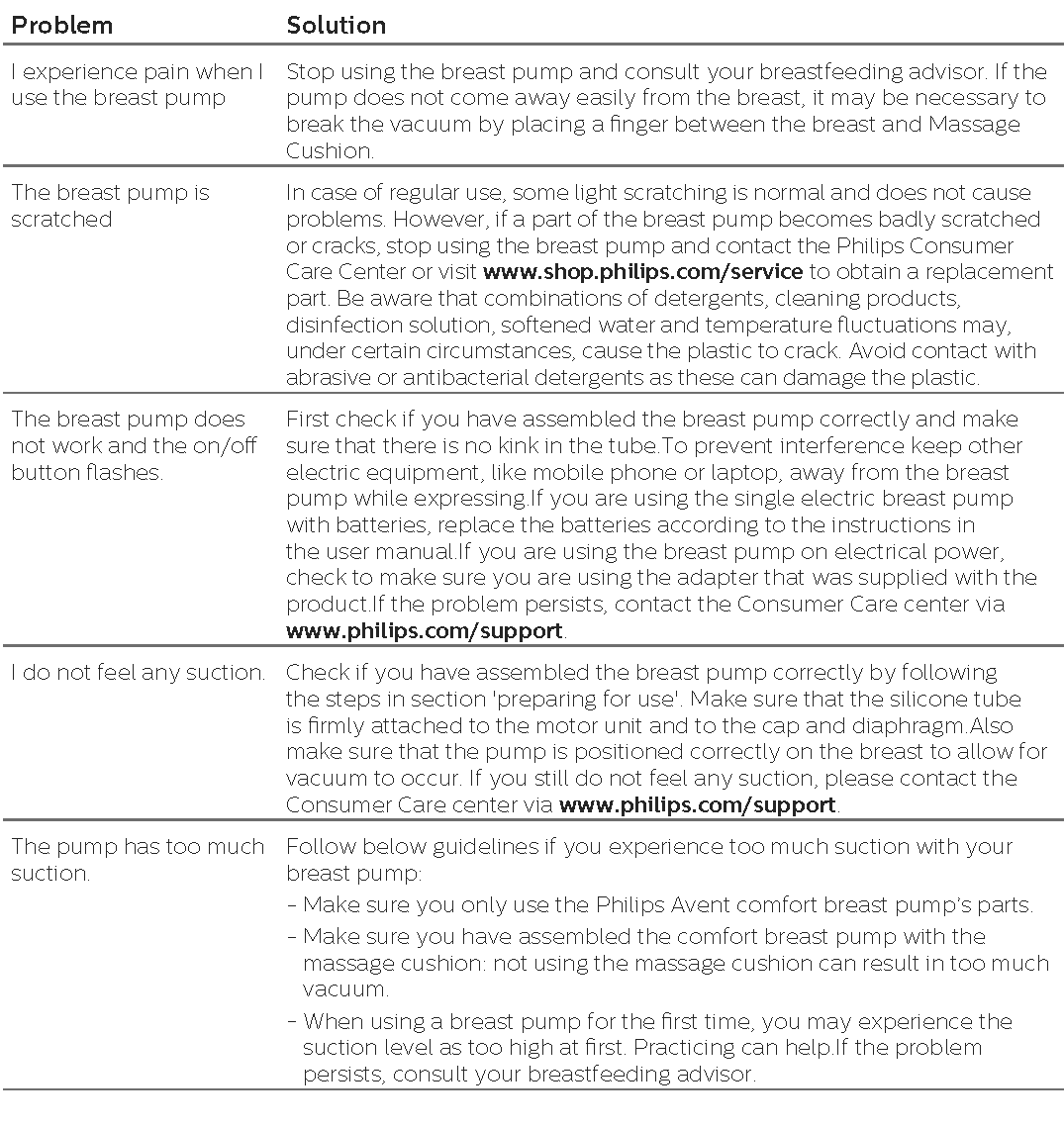
Supplemental information
Below some common breastfeeding-related conditions are described. If you experience any of these symptoms, contact a healthcare professional or breastfeeding specialist.
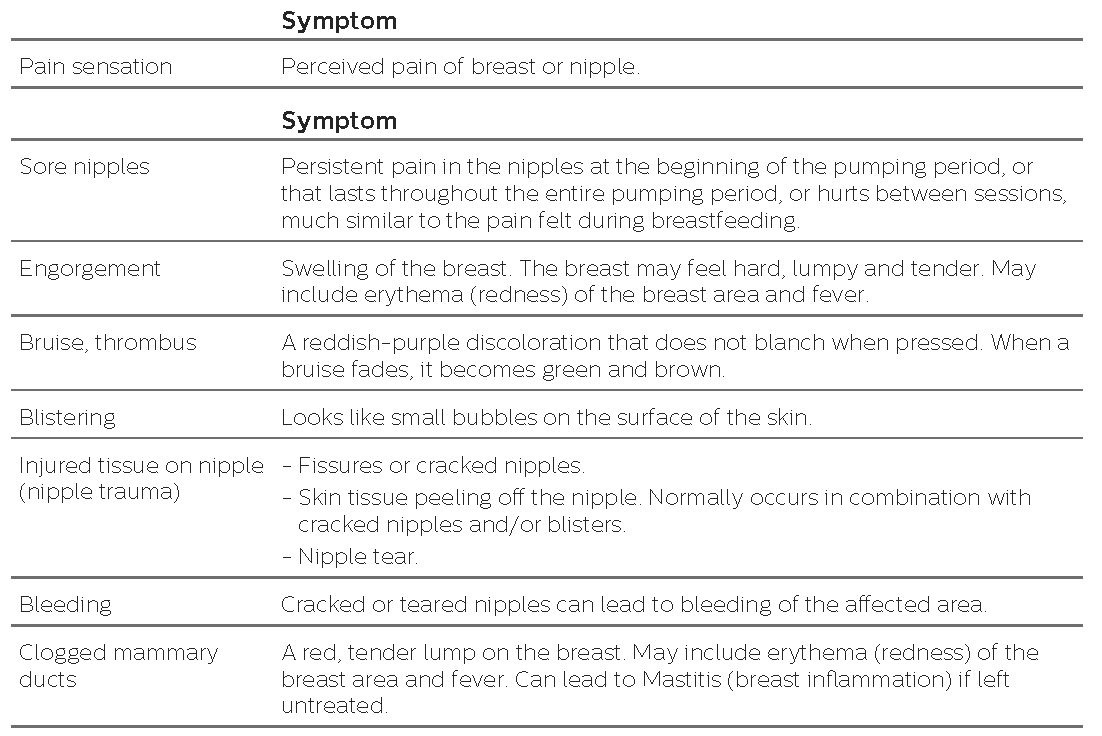
Technical information
EMC information
The Philips Avent breast pump needs special precautions regarding EMC and needs to be installed and put into service according to the EMC information provided in this section.
Portable and mobile RF communications equipment can affect the Philips Avent breast pump.The electronic breast pump has no essential performance. Due to EMC influences, like wireless home network devices, mobile phones or cordless telephones, the breast pump can turn off or go into error mode. This will not lead to unacceptable risks. To prevent interference, keep other electric equipment at least 3.3 feet/1.0 m away from the breast pump during expressing and do not stack with other electrical equipment. Cable length of the adapter: 2.50 meter/ 8.2 feet.Electromagnetic Compatibility (EMC, IEC 60601-1-2)
Declaration – electromagnetic emissionsThe Philips Avent breast pump is intended for use in the electromagnetic environment specified below. The user of the Philips Avent breast pump should assure that it is used in such an environment.
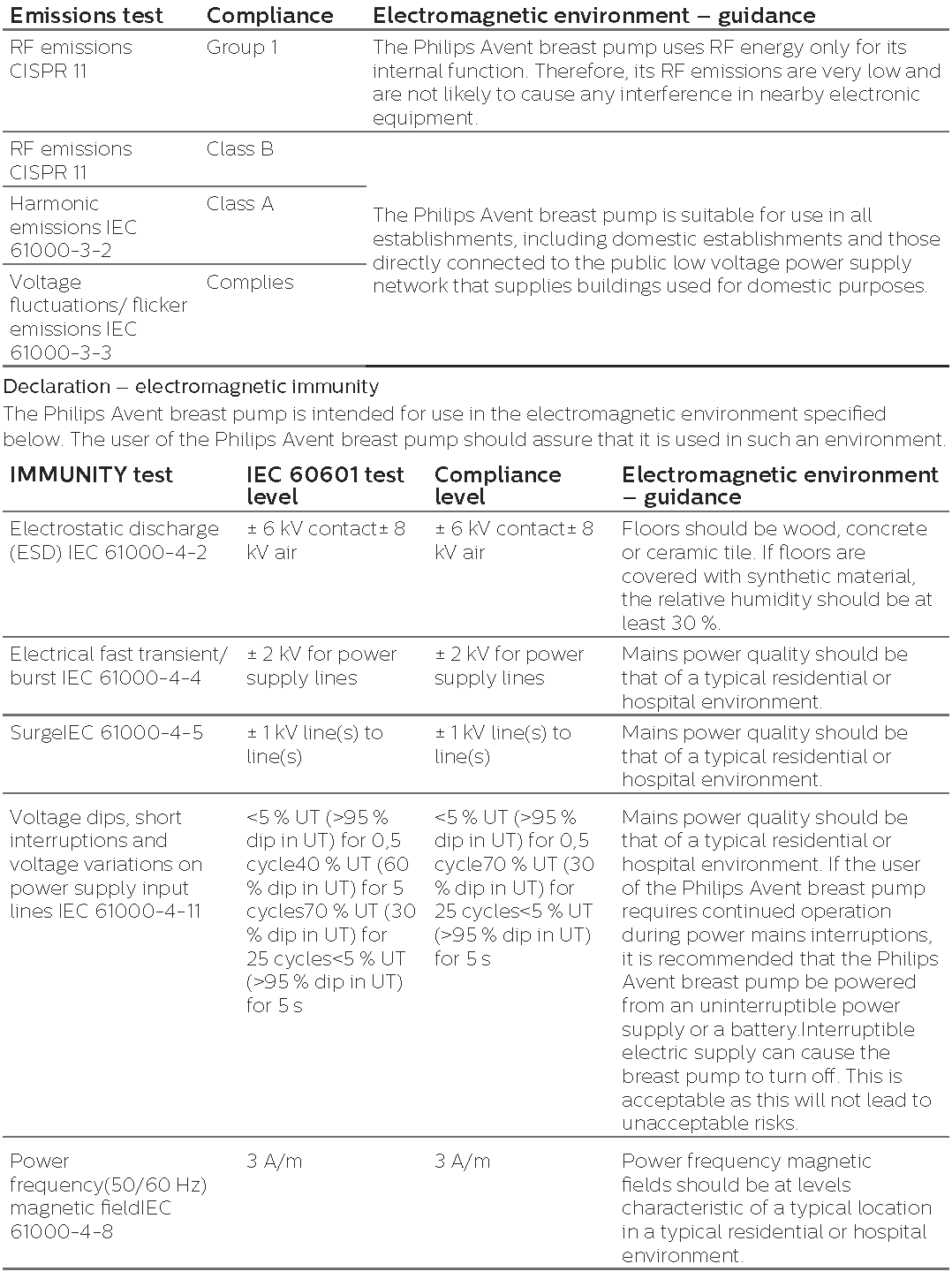
Declaration – electromagnetic immunityThe Philips Avent breast pump is intended for use in the electromagnetic environment specified below. The user of the Philips Avent breast pump should assure that it is used in such an environment.

Note 1: At 80 MHz and 800 MHz, the higher frequency range applies.Note 2: These guidelines may not apply in all situations. Electromagnetic propagation is affected by absorption and reflection from structures, objects and people.
Field strengths from fixed transmitters, such as base stations for radio (cellular/cordless) telephones and land mobile radios, amateur radio, AM and FM radio broadcast and TV broadcast cannot be predicted theoretically with accuracy. To assess the electromagnetic environment due to fixed RF transmitters, an electromagnetic site survey should be considered. If the measured field strength in the location in which the Philips Avent breast pump is used exceeds the applicable RF compliance level above, the Philips Avent breast pump should be observed to verify normal operation. If abnormal performance is observed, additional measures may be necessary, such as re-orienting or relocating the Philips Avent breast pump.Over the frequency range 150 kHz to 80 MHz, field strengths should be less than [3] V/m.Recommended separation distances between portable and mobile RF communications equipment and the Philips
Avent breast pumpThe Philips Avent breast pump is intended for use in a home healthcare environment in which radiated RF disturbances are not controlledThe user of the Philips Avent breast pump can help prevent electromagnetic interference by maintaining a minimum distance between portable and mobile RF communications equipment (transmitters) and the Philips Avent breast pump as recommended below, according to the maximum output power of the communications equipment.
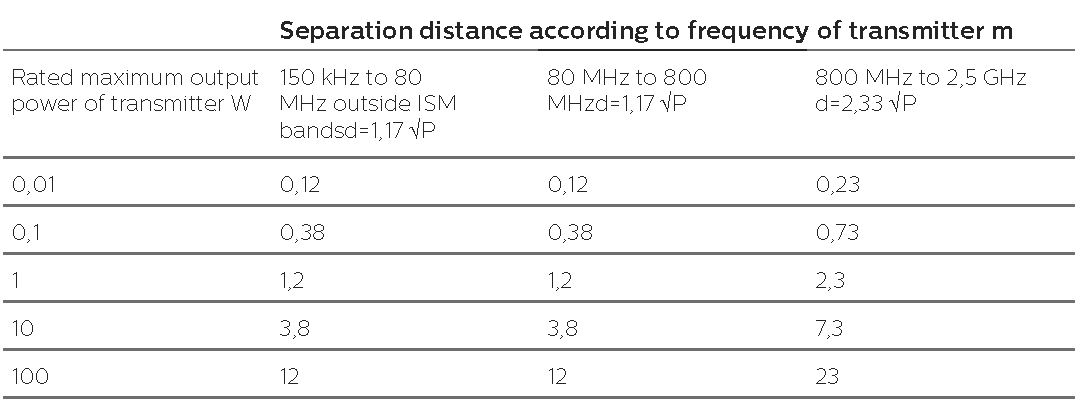
For transmitters rated at a maximum output power not listed above, the recommended separation distance d in metres (m) can be estimated using the equation applicable to the frequency of the transmitter, where P is the maximum output power rating of the transmitter in watts (W) according to the transmitter manufacturer.
NOTE 1: At 80 MHz and 800 MHz, the separation distance for the higher frequency range applies.NOTE 2: These guidelines may not apply in all situations. Electromagnetic propagation is affected by absorption and reflection from structures, objects and people.
Usage and storage conditions
Keep the breast pump out of direct sunlight as prolonged exposure may cause discoloration. Store the breast pump and its accessories in a safe, clean and dry place.
If the appliance has been stored in a hot or cold environment, place it in the usage environment to let it reach a temperature within the usage conditions ( 41°F / 5°C to 104°F / 40°C ) before you use it.

Technical specifications
The adapter is not a part of the medical electric equipment, but is a separate power supply within the medical electric system.
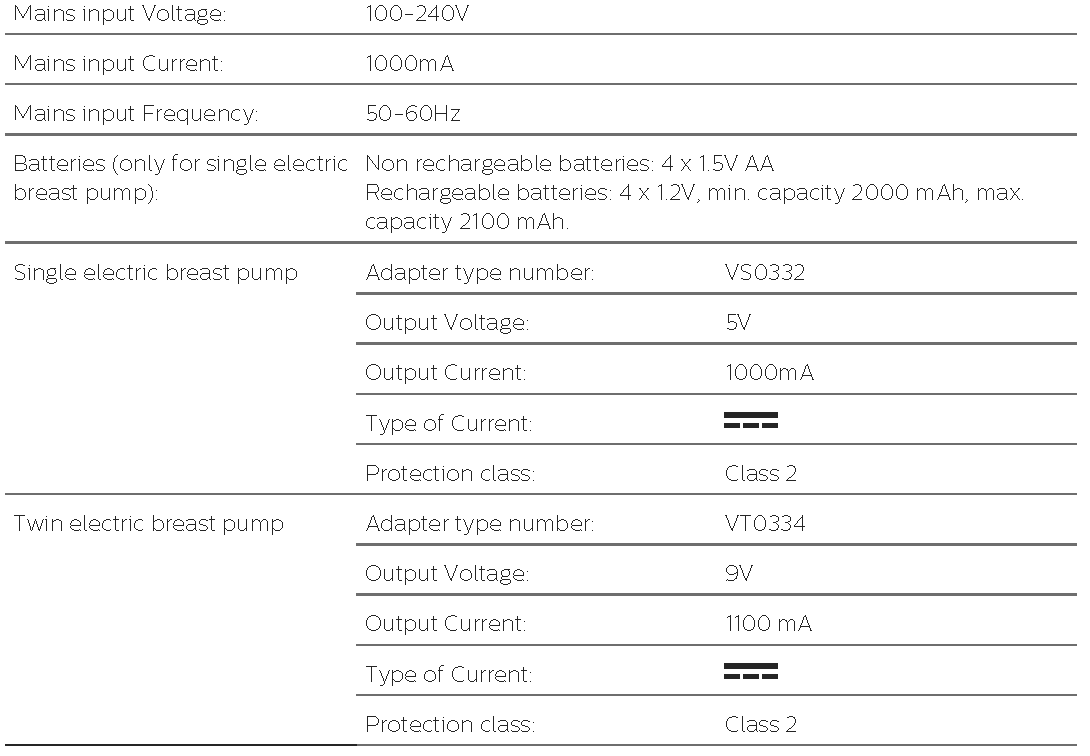
Explanation of symbols
The warning signs and symbols are essential to ensure that you use this product safely and correctly and to protect you and others from injury. Below you find the meaning of the warning signs and symbols on the label and in the user manual.

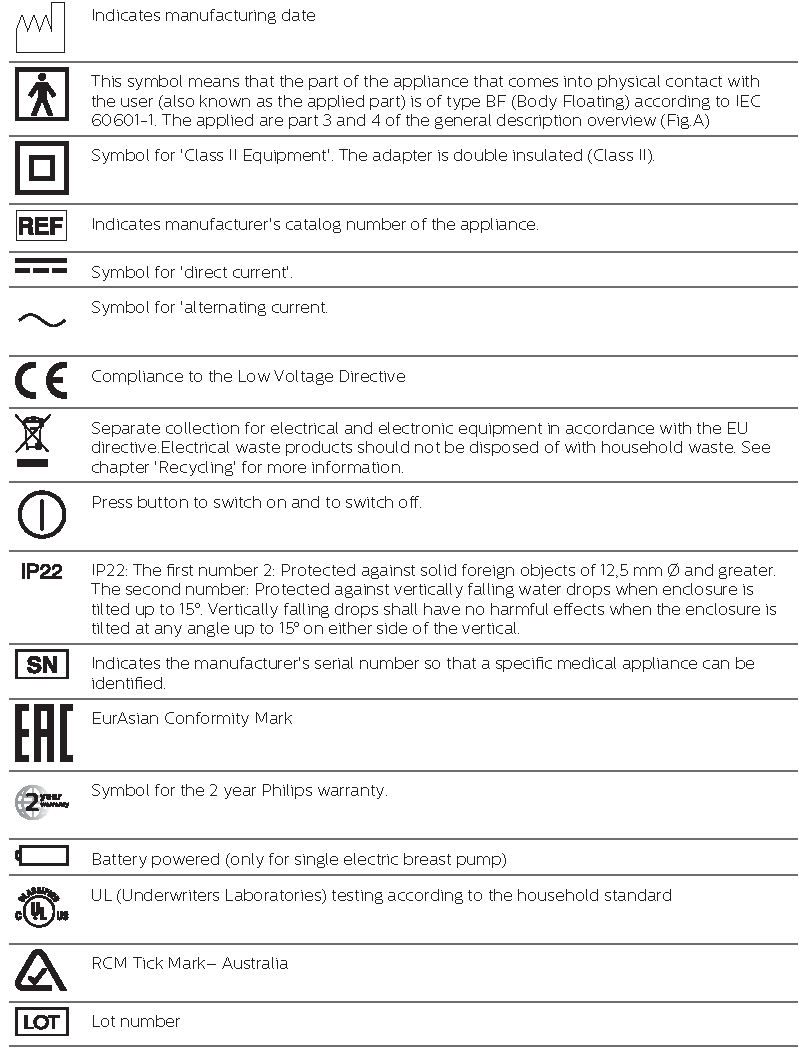

References
[xyz-ips snippet=”download-snippet”]

